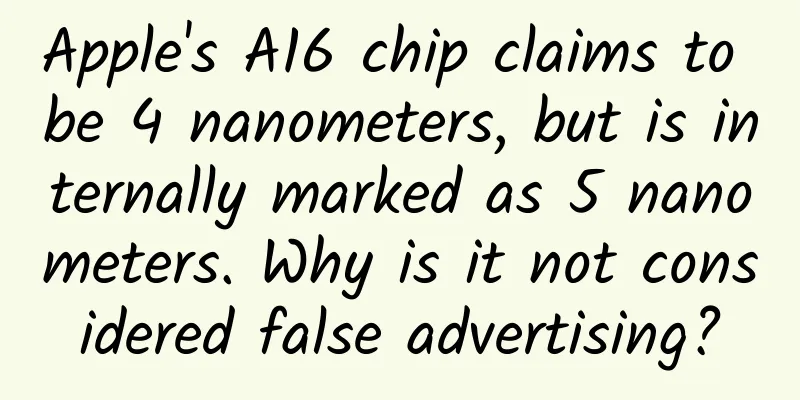Apple's A16 chip claims to be 4 nanometers, but is internally marked as 5 nanometers. Why is it not considered false advertising?

|
Recently, there was news that the A16 Bionic chip equipped in Apple's iPhone 14 Pro series is not manufactured using TSMC's 4nm process as advertised, but is actually a 5nm chip. This statement has aroused the attention and doubts of the industry and consumers. Is Apple engaging in false propaganda and misleading consumers? According to media reports, the well-known whistleblower @URedditor said on Twitter that he saw the A16 Bionic chip marked as a 5nm chip instead of a 4nm chip inside Apple. He also revealed that Apple's next-generation A17 Bionic chip will use TSMC's 3nm process, and its performance will be greatly improved. In addition, he also pointed out that Qualcomm's Snapdragon 8 Gen 2 chip is also manufactured based on the 5nm process, rather than the advertised 4nm process. So why did Apple claim that the A16 Bionic chip is made using a 4nm process? Does this mean that Apple is deceiving consumers? To answer these questions, we first need to understand what a semiconductor process is and how it is defined and measured. Semiconductor process, in simple terms, refers to a specific semiconductor manufacturing process and its design rules. Different processes mean different circuit characteristics. Generally speaking, the smaller the process node, the smaller the transistor, the faster the speed, and the better the energy consumption performance. However, not all transistor sizes can be represented by a single number. In fact, with the development of technology and fierce competition, the semiconductor industry no longer has a unified and accurate standard to define and name process nodes. In the past, process nodes usually corresponded to the gate length or half-pitch of transistors (that is, half the distance between the interconnects inside the chip). For example, in 2005, a 65nm process meant a transistor gate length of 65nm. However, in recent years, due to various technological innovations and marketing strategies, this correspondence has lost its meaning. For example, in 2018, the transistor gate length of TSMC's 7nm process was 40nm, while the transistor gate length of Samsung's 7nm process was 27nm. This makes it difficult to directly compare process nodes between different foundries, and also confuses consumers. Therefore, the current process node is only a relative concept. It can only indicate the degree of advancement of a certain generation of technology relative to the previous generation of technology, rather than an absolute physical quantity. Each process generation doubles the density of transistors on a chip, with each successive process node named about 0.7 times smaller than the previous one - linear scaling means doubling the density. So, there are 90nm, 65nm, 45nm, 32nm, and so on. However, not all process nodes follow this rule, and sometimes there are some "half nodes", such as 22nm, 16nm, 12nm, etc., which are just some optimizations and improvements based on the previous generation of process, and do not achieve a two-fold density increase. So, is the Apple A16 Bionic chip 4nm or 5nm? According to TechInsights' analysis, Apple's A16 Bionic chip uses TSMC's N4 process, which is a half node of TSMC's N5 process. It does not achieve a two-fold density increase, but only makes a 5% optical shrink (10% area reduction) based on the N5 process. Therefore, physically, it still belongs to the category of 5nm process. The reason why Apple claims that it is a 4nm process may be due to marketing and competitive considerations to show its technological leadership. From this perspective, Apple is not deceiving consumers, but just using a more attractive number to name the process of its chips. After all, in the semiconductor industry, this kind of number game is commonplace, and different foundries and chip manufacturers have their own naming methods and standards. When consumers choose chip products, they should not only look at the process node number, but should comprehensively consider the chip's performance, power consumption, stability, compatibility and other factors. As a winner of Toutiao's Qingyun Plan and Baijiahao's Bai+ Plan, the 2019 Baidu Digital Author of the Year, the Baijiahao's Most Popular Author in the Technology Field, the 2019 Sogou Technology and Culture Author, and the 2021 Baijiahao Quarterly Influential Creator, he has won many awards, including the 2013 Sohu Best Industry Media Person, the 2015 China New Media Entrepreneurship Competition Beijing Third Place, the 2015 Guangmang Experience Award, the 2015 China New Media Entrepreneurship Competition Finals Third Place, and the 2018 Baidu Dynamic Annual Powerful Celebrity. |
Recommend
Wen Xiaogang: What is a quantum bit? | The Door to Wonders
A bit is something that has two values: 0 and 1. ...
What is the exposure mechanism of information flow advertising?
When doing information flow advertising, you may ...
How can a UI designer who has been working for one or two years and is still standing still advance in his studies?
As you all know, for a long time we have been ins...
Cutting-edge practical experts: SEO trend prediction for 2016!
Search engine optimization has become one of the ...
How much does it cost to be an agent of Nanyang Photo Mini Program? What is the price of being an agent for Nanyang Photo Mini Program?
Is it easy to be an agent of Nanyang Photo Mini P...
The prerequisite for TV to be artificial intelligence is that the people who buy TVs have low IQ
The tech industry, which used to be full of posit...
Honda accelerates electrification in the Chinese market and decides not to sell fuel-powered models after 2027
In a recent media interview, Sanae Seimura, deput...
What are the key points to consider in a good event planning proposal?
This article will share ideas for event planning ...
Logitech x Baidu Brain VOICE M380 Voice Wireless Mouse Review: Free your hands and speak fluently
As the saying goes, the driving force behind tech...
What’s so special about the paper used in Apple’s new book?
Last year, Apple released a set of product design ...
Tencent Advertising Marketing Optimization Strategy
Please explain in detail what kind of promotional...
How can I convert and monetize the user if I don’t have a strong relationship with him?
A reader asked this question. I think this questi...
Why are there so many strong earthquakes in Xinjiang? Will there be strong aftershocks? Expert analysis
According to the official measurement of the Chin...
5 Steps to Develop Your Brand on Xiaohongshu
Among the projects I have served over the years, ...
What to do if your phone becomes slower and slower? Turn off these 4 switches and your phone will be as smooth as new in an instant
For most people, spending thousands of dollars on...









